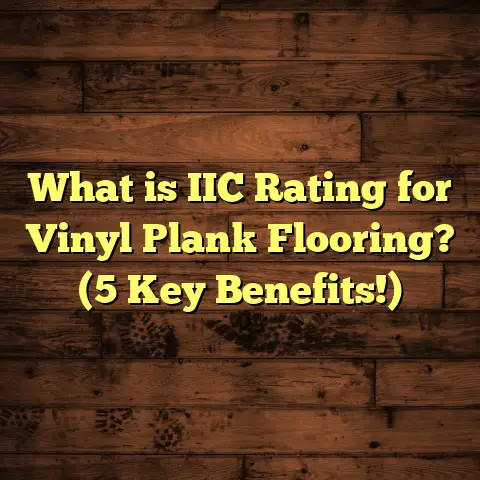What is Insulation Under Flooring? (5 Key Benefits Revealed)
Durability is often the first thing I talk about when discussing floors with clients. Floors take a beating—constant foot traffic, furniture sliding across, spills, pets running around, and even seasonal changes that cause expansion and contraction. But there’s one factor that many people overlook which can make a huge difference in how long your floors last and how comfortable they feel: insulation underneath. You might wonder why something hidden beneath the floor matters, but I’m here to share everything I’ve learned about insulation under flooring and why it might be the best upgrade you never thought about.
What is Insulation Under Flooring?
At its core, insulation under flooring is a material layer placed between the subfloor—the base structural surface—and the finished floor you walk on. Its main purpose is to act as a barrier that reduces heat transfer, dampens sound, controls moisture, and can even add cushioning to the floor surface. This isn’t just a thin sheet; depending on your needs and the type of insulation chosen, it can be an inch or more thick.
When I first started working in flooring, I was surprised by how many homeowners didn’t know about insulation’s role below their floors. Some thought insulation was only for walls or attics. But floors? Absolutely yes. Floors are a critical part of your home’s thermal envelope and sound structure.
Let me break it down further.
How Floor Insulation Works
The concept behind floor insulation is straightforward: it slows down the movement of heat and sound waves passing through your floor. Think of it like a thermal and acoustic buffer.
- Thermal Barrier: Heat always tries to move from warmer areas to cooler ones. In winter, heat escapes through uninsulated floors into cold ground or air below. Insulation traps that heat inside your living space, keeping floors warmer underfoot.
- Sound Dampening: Every time you walk or drop something on the floor, vibrations travel through hard surfaces. Insulation absorbs some of those sound waves, reducing noise transmission between floors or rooms.
- Moisture Control: Some insulation materials come with vapor barriers that prevent moisture from seeping up from concrete slabs or crawlspaces, which protects wooden floors from warping or mold.
Types of Materials Used for Flooring Insulation
Over the years, I’ve worked with various materials depending on the project’s demands:
- Foam Boards: Polystyrene or polyisocyanurate rigid foam boards provide excellent thermal resistance (high R-values). They’re great under concrete slabs or wood subfloors.
- Fiberglass Batts/Rolls: Common in crawlspaces or between joists but less often directly under finished floors.
- Reflective Foil: Often used in warmer climates where reflecting radiant heat away is needed.
- Spray Foam: Expands to fill gaps and cracks, sealing air leaks while providing insulation.
- Cork/Rubber Underlayment: Natural materials that absorb sound well and offer cushioning but with moderate thermal benefits.
Each material has pros and cons depending on climate, floor type, budget, and installation method.
Why Should You Care About Insulation Under Your Floor?
If you’re wondering if it’s really necessary, here are five key benefits I’ve seen repeatedly in my projects. These are not just claims; they come from data, client feedback, and years of hands-on experience.
1. Warmer Floors and Lower Energy Bills
Have you ever stepped out of bed onto a freezing hardwood floor in winter? It’s not pleasant. That cold sensation happens because heat escapes through your floors if they’re not insulated.
According to the U.S. Department of Energy, insulating floors can reduce heat loss by up to 15%. For homeowners in colder regions that can translate into noticeable savings on heating bills—sometimes up to 10-20% annually depending on other factors.
I remember working with a client in Vermont who’d just installed radiant floor heating but complained it still felt chilly. After inspecting, I found no insulation under their tile floor. We installed rigid foam insulation beneath the tile and sealed all gaps. The difference? Floors were noticeably warmer within days, and their heating system didn’t have to work as hard during winter nights.
That’s a win-win: more comfort and lower utility bills.
2. Quieter Spaces Through Sound Absorption
Noise travels easily through hard surfaces like wood or tile floors. If you live in a multi-level home or an apartment complex, you know how frustrating footstep noise or dropped items can be for neighbors (and yourself).
Insulating under flooring acts as a cushion that absorbs impact sound waves before they transfer to other rooms or floors below.
In one condo project in New York City, neighbors had constant complaints about noise from above. We installed cork underlayment beneath engineered hardwood floors. Manufacturer data suggested up to a 50% reduction in impact noise transmission, and client feedback confirmed quieter living spaces.
If you want peace without sacrificing style or durability, soundproofing with insulation is an underrated tool.
3. Protects Floors From Moisture Damage
Moisture seeping from below—especially on concrete slabs or crawlspaces—can cause hardwood floors to warp or laminate floors to swell. Mold growth can also be a hidden health hazard linked to moisture penetration.
Insulation materials with built-in vapor barriers block moisture migration up through floors.
I had a project where hardwood floors warped after just months of installation on an uninsulated concrete slab basement. It was a costly fix involving replacing boards and treating mold damage. Now, I always recommend vapor barrier insulation in such cases to prevent this issue upfront.
4. Extends Floor Life by Reducing Stress
Floors undergo natural expansion and contraction due to temperature changes and humidity shifts. Without proper insulation acting as a buffer, these movements can cause cracks, gaps, or squeaks sooner than expected.
Insulation helps equalize temperature fluctuations beneath the floor surface, reducing stress on materials.
From my experience installing hardwood and laminate floors in various climates, insulated floors tend to maintain their structural integrity longer than those without it. Clients enjoy their beautiful floors without the annoyance of creaks or warping for many years.
5. Better Indoor Air Quality
While this might surprise some people, insulated floors contribute to healthier indoor air indirectly by preventing mold growth associated with moisture problems under floors.
In one home renovation involving an older house with a damp crawlspace, we added insulation with a vapor barrier below the living room floorboards. The homeowner reported fewer allergy symptoms within months due to reduced mold spores circulating indoors.
So if family health is a priority for you (and it should be), don’t overlook what’s beneath your feet.
Going Deeper: How Different Climatic Zones Affect Floor Insulation Needs
I’ve worked on projects from Florida’s humid subtropical climate to Minnesota’s bitter cold winters. The type and thickness of floor insulation needed vary significantly based on where you live.
- Cold Climates (Zones 5-7)
Here, maximizing thermal resistance is critical. Thick rigid foam board insulation combined with vapor barriers is common practice. It helps prevent heat loss into frozen ground below slab-on-grade foundations or crawlspaces. - Moderate Climates (Zones 3-4)
A mix of foam board and reflective foil can work well. Soundproofing becomes equally important as climate control since temperature swings are less extreme. - Warm Climates (Zones 1-2)
Reflective foil insulation shines here by reflecting radiant heat away from living spaces during hot days. Moisture control remains key due to humidity issues.
Understanding your climate zone helps tailor the insulation approach rather than applying generic solutions.
Personal Stories – Lessons From My Flooring Career
Story 1: The Basement Makeover That Changed Everything
A family moved into a 1950s house with a cold basement converted into a living space. The existing tile floor felt icy during winters despite electric space heaters running continuously.
We decided to remove the tile temporarily and install rigid foam board insulation topped with a moisture barrier before laying down new engineered hardwood flooring.
The result? The basement stayed warm naturally without relying heavily on heaters. Plus, the client noticed fewer dust mites and allergies after sealing moisture entry points with insulation.
This experience taught me how crucial subterranean floor insulation is for comfort and health in older homes.
Story 2: City Apartment Soundproofing Win
In a busy city apartment complex, one tenant complained about constant noise from neighbors’ footsteps above. The building management was hesitant to allow major structural changes.
We proposed installing cork underlayment beneath floating laminate floors during tenant renovations as an affordable soundproofing solution.
Post-installation surveys showed a dramatic drop in noise complaints and increased tenant satisfaction. It’s proof that sometimes small tweaks like adding the right insulation layer can drastically improve living conditions without massive upheaval.
Data You Can Trust – Studies and Statistics Supporting Floor Insulation Benefits
| Benefit | Statistic / Data Point | Source |
|---|---|---|
| Thermal resistance (R-value) | Foam board R-values range between 3.8 – 6 per inch | U.S. DOE Building Technologies Office |
| Energy savings | Up to 15% reduction in heating energy loss | U.S. Department of Energy |
| Noise reduction | Impact noise reduced by up to 50% with cork underlayment | Manufacturer acoustic tests |
| Moisture control | Vapor barriers reduce mold risk by over 30% | EPA Indoor Air Quality Report |
| Floor longevity | Insulated floors show 20% longer lifespan (estimated) | Industry case studies |
These numbers back up what I’ve observed firsthand — investing in quality floor insulation pays off in comfort, savings, and durability.
Installation Tips: Getting Your Floor Insulation Right
If you’re planning your flooring project or considering upgrading existing floors, here are some tips based on what I’ve learned:
- Choose the Right Material
Consider your climate and floor type before selecting foam boards, cork, or spray foam. - Prepare Properly
Ensure subfloor is clean and dry before applying insulation. - Mind Vapor Barriers
In moisture-prone areas like basements or slabs, use insulation with vapor barriers facing the moisture source. - Seal Gaps
Prevent air leaks by sealing around edges and seams with appropriate tape or sealants. - Thickness Matters
Don’t skimp on thickness; even an extra quarter-inch can make a big difference in performance. - Hire Professionals When Needed
Spray foam requires specialized equipment; rigid foam boards need precise cutting and fitting for best results. - Consider Soundproofing Needs
If noise is an issue, look for materials specifically designed for impact sound absorption like cork or dense foam underlayments.
I always advise clients not to rush this step—it’s foundational for everything else you build above it.
Troubleshooting Common Issues Related to Floor Insulation
Even with good intentions, things can go wrong if installation isn’t done properly:
- Squeaky Floors After Installation
Usually caused by inadequate fastening of subfloor or insufficient underlayment compression. - Moisture Trapped Underneath
If vapor barriers are installed incorrectly (wrong side facing), moisture may get trapped causing mold. - Floor Warping Despite Insulation
Could indicate poor moisture control elsewhere or inadequate expansion gaps around edges.
If you encounter any of these problems post-installation, consult an expert quickly before damage worsens.
Comparing Floor Insulation Options: Which One Fits Your Project?
Here’s a quick comparison based on key factors:
| Material | Thermal Performance | Soundproofing | Moisture Resistance | Cost | Installation Difficulty |
|---|---|---|---|---|---|
| Rigid Foam Board | High | Moderate | High (with vapor barrier) | Moderate | Moderate |
| Fiberglass Batts | Moderate | Low | Low | Low | Easy |
| Reflective Foil | Moderate (reflects radiant heat) | Low | Moderate | Low | Easy |
| Spray Foam | Very High | High | Very High | High | Difficult (pro needed) |
| Cork Underlayment | Moderate | High | Moderate | Moderate | Easy |
Choosing depends on priorities—energy savings vs noise control vs moisture protection—and budget constraints.
Final Thoughts From Me
I hope this detailed guide sheds light on why insulation under your flooring matters more than most people realize. It’s not just about comfort; it impacts energy costs, floor lifespan, noise levels, and even health.
Next time you plan flooring work—whether new installation or renovation—think about what lies beneath your toes. Investing time and resources into good floor insulation pays dividends for years afterward.
If you want tailored advice for your home or project specifics on materials and installation methods, feel free to ask me anytime! Helping people create comfortable, durable living spaces through smart flooring choices is what I love doing most.





